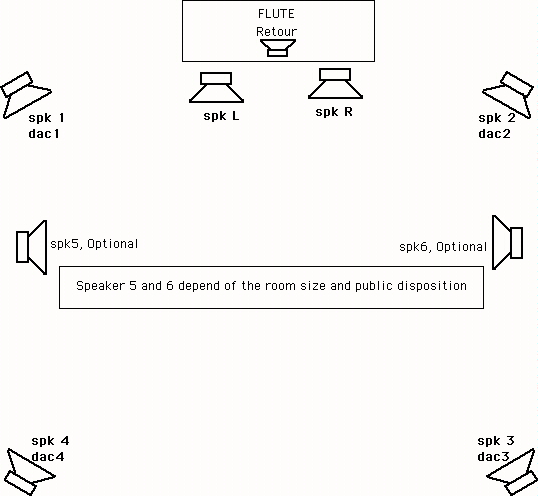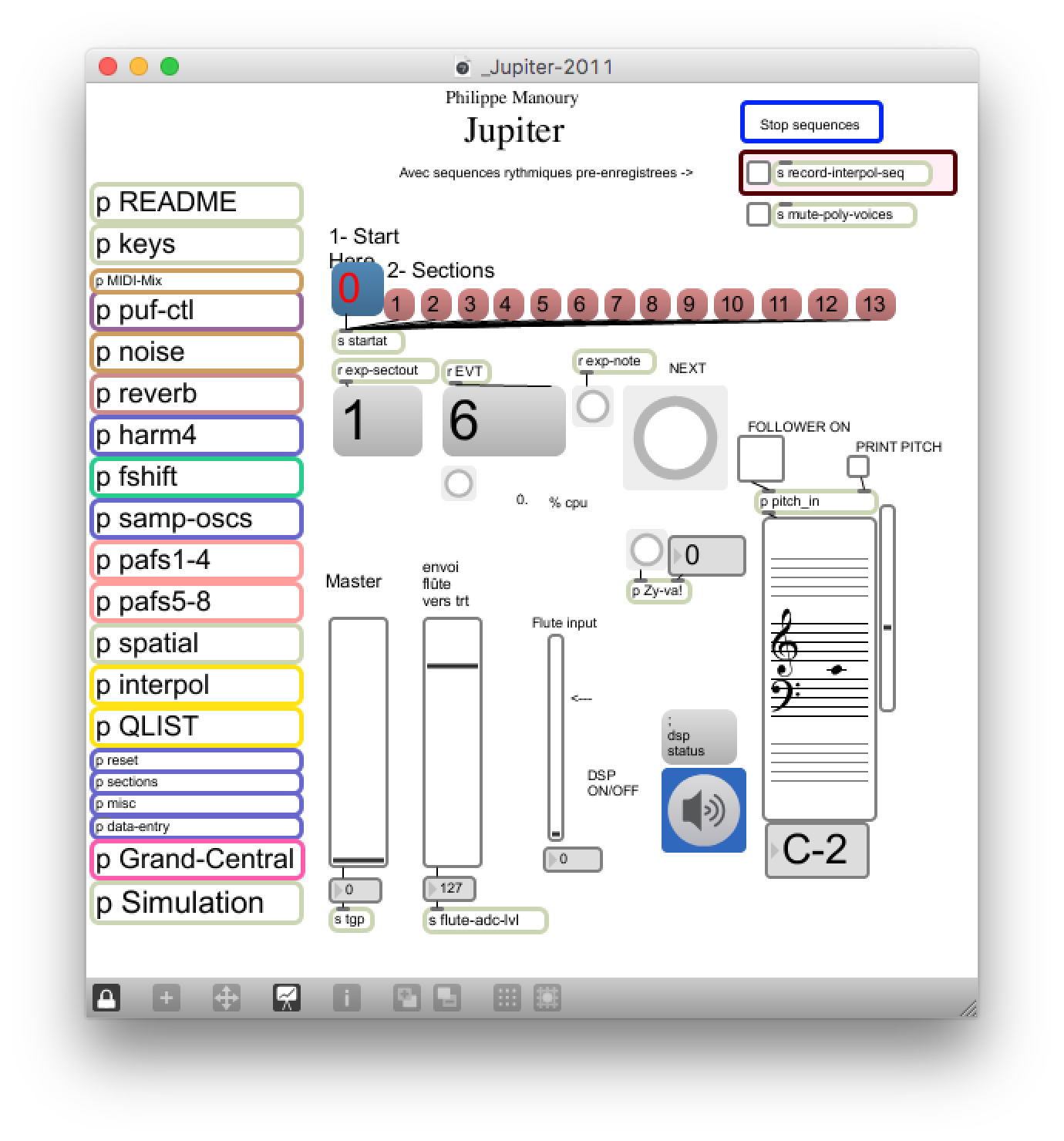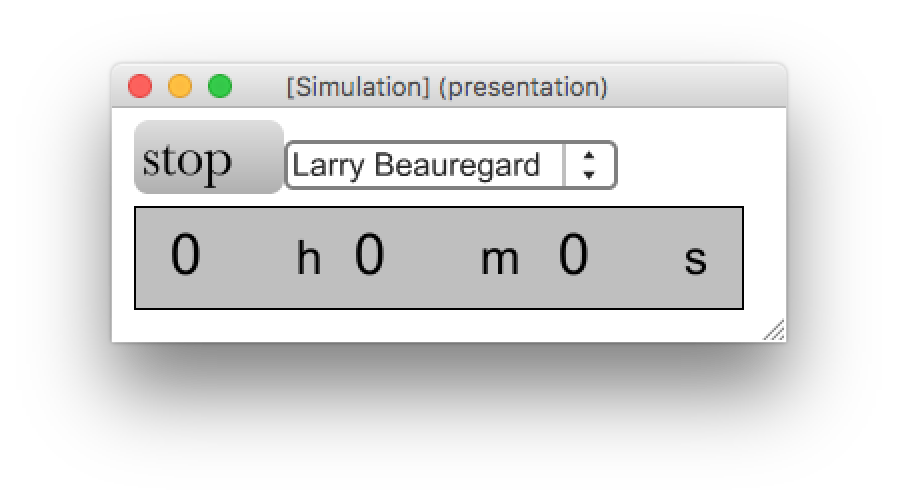Table of contents
Performance date: 14 mai 2012
Documentation date: 13 décembre 2017
Version state
Valid
Validation date: 14 février 2018
Executions dates of this version
- 14 mai 2012,
Version documentalist
- lemouton (Serge.Lemouton@ircam.fr)
Version realisation
- Grégoire Lorieux (Computer Music Designer)
Version length
25 mnUpgrade Motivation
V. Isnard:
- documentation updated from the previous versions.
G. Lorieux:
- Max 5 version
- first tests with Antescofo
Comment
G. Lorieux:
- at the end, replace the fiddle~ object by the new pitch detection fonk~ object to well detect the repeated notes.
J. Delisle (delisle.julie@gmail.com):
- played (outside IRCAM) the 14th May 2012 with the flutist Geneviève Déraspe, with this patch version and Max 5. Everything worked well.
- some modifications were done on the patch specifically for this concert (because of the broadcast system): add of a button to trigger a fade-out on the master volume at the end of the piece, adaptation of the Midi-Mix with the MIDI controller (changes with the ctlin), and add of two supplementary dac~ objects to broadcast in octophony.
V. Isnard:
- There is a bug on my computer (with Max 7 in 32bit mode) when re-opening the patch after having closed it:
1. Open Max --> configure File Preferences;
2. Open and run the patch --> it works;
3. Close Max;
4. Re-open the patch on Max --> "stack overflow" when clicking on a section button.
5. SOLUTION: close the patch;
6. File Preferences: remove, and then re-add the path;
7. Re-open the patch --> it works again.
Other version(s)
- Philippe Manoury - Jupiter - Anniversary Edition-2022-Max8
- Philippe Manoury - Jupiter - PureData-2022
- Philippe Manoury - Jupiter - PureData-2021
- Philippe Manoury - Jupiter - PureData
- Philippe Manoury - Jupiter - 2011-dijon-Max4
- Philippe Manoury - Jupiter - Max5-fevrier-2011
- Philippe Manoury - Jupiter - Seoul
- Philippe Manoury - Jupiter - Mac OS X
- Philippe Manoury - Jupiter - Mac OS 9
Detailed staff
- flûte
Electronic equipment list
Computer Music Equipment
-
1 MacBook Pro - Apple Laptops
(Apple)
-
1 Max 5 - Max
(Cycling74)
-
1 Fireface 802 - Sound Board
(RME)
-
1 MIDI Mixer - MIDI Mixer
Connected to the computer for the internal mixing of the electronic layers (cf. sub-patch MIDI-Mix) (9 channels)
Audio Equipment
-
1 Dynamic microphone - Dynamic Microphones
Attached to the flute (ex.: SD System) -
2 Loudspeaker - Loudspeakers
Stereophony -
1 O2R - Digital Mixers
(Yamaha)
4 aux, 6 bus, 10 inputs -
1 M300 - Effects Processor
(Lexicon)
Global reverb of the flute, if necessary -
1 Effect processor - Effects Processor
Compressor to pre-process the flute sound before the Macintosh input for pitch tracking (ex.: Yamaha O2R internal effect)
Work related information
Premiere
- None,
- 25 avril 1987, Paris, Ircam, Espace de Projection
Publisher :
- Durand
Realisation
- Marc Battier
- Cort Lippe
Work length
- 37 mn
Useful links on Brahms
- Jupiter pour flûte et électronique temps-réel (1992), 37mn
- Philippe Manoury
| File | Author(s) | Comment | |
|---|---|---|---|
| Download [162,7 Mio] | Patch Jupiter-Max5-2011-2017.dmg |
Instructions
Audio setup

Loudspeaker setup

Midi setup
A MIDI mixer with at least 9 faders (cf. MIDI-Mix sub-patch on the main patch) is used by the composer to control the internal mixing of the electronic layers.
Software installation
All the electronic part is managed in Max.
Max/MSP Patches
On the Macintosh laptop:
1. Copy all the contents of the zip file.
2. Set the Max 5 File Preferences to include this folder.
3. Open _Jupiter-2011.maxpat with Max 5.
4. Configure the DSP Status Options :
* Fe = 44100 Hz;
* IO Vector Size = 512;
* Signal Vector Size = 64;
* Scheduler in Overdrive ON;
* Scheduler in Audio Interrupt ON;
* Vector Optimization ON.
Routing in Max/MSP
ADC:
1. Flute input (the mic as close as possible to the flute).
DAC:
1. Stereo Left;
2. Stereo Right;
3. Quadriphony Front Left;
4. Quadriphony Front Right;
5. Quadriphony Rear Right;
6. Quadriphony Rear Left;
7. Flute simulation (1/2): for testing purpose, not for the concert;
8. Flute simulation (2/2): idem.
Patch presentation
Main patch

Main sub-patch

In the “Grand-Central” subpatch is where is done the routing.
It is also where you find the “pitch_fol” sub-patch for the pitch detection (and the sfplay~ for simulation) to automatically trigger the events (cf. also the “QLIST” sub-patch in the main patch).
Shortcuts
ESC = DSP on/off;
TAB = next event;
0 = follower off;
, = follower on.
System calibration and tests
1. Play section 8 event 2 (this is a sequence of tam-tam sounds) (click on the button “NEXT” to manually trigger the events).
2. Test the score follower with the flute simulation :
Start section 1.
Open the sub-patch “Simulation”.
Click on the message box to begin the simulation.
You can listen to the whole piece (outputs 7 and 8 play the flute simulation).

Initialization routine
To initialize the patch:
1. Turn audio ON;
2. Click the init button “Start here: 0”: the “follower on” toggle is ON;
3. Click on the button “Section 1” and on the button “NEXT” to trigger the first event.
4. The events are automatically triggered with a pitch follower.
Details: history
1987: Original version
Duration: 38’
Publisher: Durand, Paris
Musical assistants: Marc Battier, Cort Lippe
Scientific assistants: Miller Puckette, Olivier Koechlin
Performer: Pierre-André Valade
First performance: April 25th 1987, Espace de Projection, IRCAM, Paris
Instrumentation: MIDI flute, 4X computer (IRCAM dedicated real-time sound computing processor)
1992: NeXT/ISPW Version
Duration: 28’
Publisher: Durand, Paris
Musical assistant: Miller Puckette
Performer: Sophie Cherrier
First performance: July 1992, Avignon
Instrumentation: MIDI flute, NeXT/ISPW (IRCAM Signal Processing Workstation)
2002: Finnish Institute
Duration: 30’
Publisher: Durand
Musical assistant: Serge Lemouton
Performer: Ishiro Nodaira
Dedication: to Lawrence Beauregard
Sidney version: “Mac OS 9”
2004
Sidney version: “Mac OS X”
2006
Sidney version: “Seoul”
2008
Musical assistant: Serge Lemouton ?
Version: “Nanterre-2008” ?
2011
Musical assistant: Serge Lemouton ?
Version: “Luxembourg-2011” ?
2011
Musical assistant: Grégoire Lorieux
Sidney version: “2011-dijon-Max4”
2012 (not IRCAM)
Musical assistant: Julie Delisle
Performer: Geneviève Déraspe
Sidney version: “Max5-fevrier-2011”
See also: Pure Data reference version
Musical assistant: Serge Lemouton
Sidney version: “PureData”
© IRCAM

This documentation is licensed under a Creative Commons Attribution-NonCommercial-NoDerivatives 4.0 International License.
Program note
Le compositeur face à la machine
Jupiter est la première pièce d'un cycle à venir, dont le but est d'explorer l'interaction entre divers instruments et un système de traitement et de synthèse numérique en temps réel. Comment cela se produit-il ? Tout d'abord par le fait que la machine ressemble de plus en plus à l'homme (au musicien dans ce cas). C'est-à-dire, qu'elle écoute, attend un événement, et réagit lorsque l'événement attendu se produit. Il s'agit bien sûr de simulations, mais selon moi, la simulation, comme l'imagination est un des propres de l'art. Elle réalise une partie de ce que ferait un chef d'orchestre jouant avec un soliste. En un mot, la machine est plus intelligente, puisqu'elle reconnaît, et suit, le discours qu'on lui propose (à condition de le lui avoir appris au préalable bien sûr) et s'y adapte en fonction de critères établis entre le compositeur et elle. J'ai tenu à ce que cette pièce se déroule complètement par rapport au jeu instrumental sans interventions extérieures. Ainsi, tout ce qui proviendra de la partie synthétique ou traitée, sera déclenché, ou issu, du jeu du flûtiste. Les opérations extérieures auront pour fonction de pallier une erreur possible, ou de contrôler la diffusion du son sur les quatre haut-parleurs (pointer vers schéma de diffusion).
L'œuvre et son environnement
Jupiter explore cet environnement en essayant d'en tirer le maximum de conséquences. Au fur et à mesure de son avancée dans le temps, les relations entre l'instrument et la machine se font plus serrées. En voici les détails.
A partir du son de la flûte : le son de la flûte est reconnu et envoyé instantanément dans différents modules permettant soit de le maintenir dans le temps (reverbération prolongée aussi longtemps qu'on le désire) (pointer vers traitements électroniques), soit de le transporter dans l'espace (harmoniques modifiant la hauteur sans altérer la durée) pour en former des configurations harmonico-polyphoniques, soit, enfin, de transformer son timbre (frequency-shifters) (pointer vers frequency-shifters). Avec ces trois possibilités, combinables à volonté, on peut agir sur la durée, la hauteur et le timbre. L'idée étant que, partant d'un triple son de flûte, je l'extrapole jusqu'à devenir méconnaissable, tissant ainsi des liens entre sons connus et inconnus dans une dialectique compositionnelle.
A partir de la partition instrumentale : j'ai conçu des programmes qui permettent de détecter des séquences rythmiques jouées par l'instrumentiste, qui sont mémorisées puis placées aux extrémités d'une séquence dont le rôle sera de transformer la première séquence rythmique en petites quantités jusqu'à ce qu'elle devienne identique à la seconde (interpolations). Cette partition de rythmes servira ensuite de support à une partion de synthèse expérimentant le même principe au niveau des échelles (compression et dilatation d'échelles par interpolations successives). Trois séquences d'interpolations serviront de centres autour desquels gravitera la forme de Jupiter.
L'accompagnement synthétique : sur le suivi du jeu instrumental, se déroulera une partition de synthèse auditive tissant des accords, des contrepoints, des arpèges autour de la mélodie de la flûte. Ici, l'instrument contrôlera le début et l'extinction des événements synthétiques, mais pas leur déroulement interne. Ces sections seront des commentaires des exposés dans lesquels la flûte nourrit les programmes d'interpolations (pointer vers les programmes d'interpolation) décrits précédemment.
La variation formantique : si dans l'accompagnement synthétique, la flûte n'interagissait pas au niveau de l'évolution de la partie synthétique, par ce procédé elle peut contrôler le début et la fin des événements, comme leur évolutions internes. Une enveloppe spectrale (permettant de modifier l'amplitude des partiels d'un spectre) attachée au jeu de la flûte éclairera les tons synthétiques du grave à l'aigu suivant la position des notes de l'instrument dans l'ambitus. Ainsi se trouve réalisé un contrôle, temporel, spectral et de modulation complet d'une partition synthétique par un interprète. Je remercie Miller Puckette, [composer:288][Marc Battier], Olivier Koechlin, Cort Lippe et [composer:1982][Thierry Lancino] pour l'aide et le soutien qu'ils m'ont apportés. Jupiter est dédié à la mémoire de Lawrence M. Beauregard, trop tôt disparu, qui était à l'origine de ce projet.
Philippe Manoury, note de programme de la création, 1987.
Version documentation creation date: 13 décembre 2017 16:04, update date: 19 avril 2022 17:17